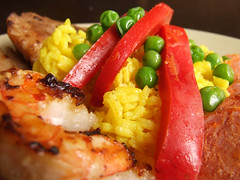This past week my La Fonera wireless router arrived, and in celebration, I invited my dad over and cooked up a deconstructed paella. I wanted to make sure there was something for everyone, and with as many differing tastes as there in the household, I knew a traditional paella was out of the question.
I began by making a pork roast:- Season the roast on each side with 1tsp salt, 1/2 tsp pepper, and a generous shake of paprika.
- Put 2 tablespoons of olive oil and two minced garlic cloves into a skillet and heat it over medium high until the garlic begins to cook (it will become slightly translucent).
!! Watch out !! Garlic can brown very easily, and some people think the taste becomes too strong when it does. - Brown the roast on each side for about 4 minutes in the skillet,
- Then move the roast to a shallow roasting pan and into a 350 degree oven.
- Leave it be fo @22 minutes per pound.
(Mine was a 2.26 pound roast, so I set the time for 50 minutes)
While the pork was roasting, I set about gathering up the rest of the ingredients:
- Scallops
- Large shrimp
- Chorizo sausage
- Red bell peppers sliced into thin strips
- Fresh green peas
- Saffron yellow rice
I cooked the chorizo, which I'd brought pre-packaged from the local market, by following the directions on the package. I just heated the chorizo in a pan. When it was done, I wrapped it in foil and set it aside, and kept the pan over the heat, set to low.
This is crucial--you want to keep all the flavor from the chorizo in the pan you cooked it in, so don't go cleaning the pan too quickly.
Immediately following that, I cooked the rice according to the directions on the package--it's perfectly serviceable rice. If you feel like making it from scratch, I'm sure there are recipes to be found.
When the rice was finished, I moved the heat of the chorizo pan up to medium-high and quickly sauteed the red bell pepper strips and searched the scallops and shrimp--about 60 seconds on each side. Scallops and shrimp cook very quickly, and it's important that they are not over done. As equally important is to cook them in the chorizo juices! This gives even the delicate scallops a rich, earthy flavor that really combines well with their usual buttery subtleties.
Once I had cooked everything, I plated the pork and seafood in a ring on a large serving dish and piled the peppers and peas in the middle. At the table, I coupled the serving dish with a big bowl of the saffron rice, and we each got to pick and choose the ingredients we enjoyed most.
What to pair it with?
Garnacha, of course! Garnacha is the Spanish word for grenache, and it is Spain's grape of choice. My own wine of choice when it comes to this bold, spicy grape is Las Rocas, an inexpensive Spanish wine that always seems to deliver consistent results. Alas, my local wine merchant had gone through their supply of Las Rocas, so I had to settle for a Bonny Doon 2004 Clos de Gilroy California grenache. Meh. The wine was very drinkable with interesting aromas and subtle fruit, but it lacked the tannic backbone to really stand up to the succulent pork and charred, smoky shrimp.




